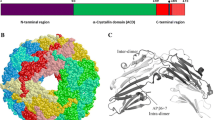Abstract.
Small heat shock proteins (sHSPs) associate with nuclei, cytoskeleton and membranes, and as molecular chaperones they bind partially denatured proteins, thereby preventing irreversible protein aggregation during stress. sHSP monomers consist of a conserved α-crystallin domain of approximately 90 amino acid residues, bordered by variable amino- and carboxy-terminal extensions. The sHSPs undergo dynamic assembly into mono- and poly-disperse oligomers where the rate of disassembly affects chaperoning. The α-crystallin domain contains several β-strands organized into two β-sheets responsible for dimer formation, the basic building block of most sHSPS. The amino-terminal extension modulates oligomerization, subunit dynamics and substrate binding, whereas the flexible carboxy-terminal extension promotes solubility, chaperoning and oligomerization, the latter by inter-subunit linkage. Crystallization studies have revealed sHSP structure and function. Additionally, site-directed mutagenesis, biophysical investigations, functional studies and the discovery of relationships between mutated sHSPs and diseases have illuminated the role of sHSP within cells.
Similar content being viewed by others
Author information
Authors and Affiliations
Corresponding author
Additional information
Received 8 May 2005; received after revision 24 June 2005; accepted 19 July 2005
Rights and permissions
About this article
Cite this article
Sun, Y., MacRae, T.H. Small heat shock proteins: molecular structure and chaperone function. Cell. Mol. Life Sci. 62, 2460–2476 (2005). https://doi.org/10.1007/s00018-005-5190-4
Published:
Issue Date:
DOI: https://doi.org/10.1007/s00018-005-5190-4




